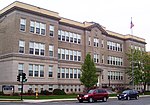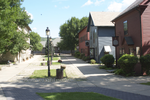Siege of Fort Massachusetts
1746 in North AmericaBattles in MassachusettsBattles involving Great BritainBattles of King George's WarBritish battle stubs ... and 8 more
Conflicts in 1746French battle stubsMilitary history of CanadaMilitary history of New EnglandNew FrancePre-statehood history of MassachusettsSieges involving FranceSieges of the War of the Austrian Succession
The siege of Fort Massachusetts (19-20 August 1746) was a successful siege of Fort Massachusetts (in present-day North Adams, Massachusetts) by a mixed force of more than 1,000 French and Native Americans from New France. The fort, garrisoned by a disease-weakened militia force from the Province of Massachusetts Bay, surrendered after its supplies of ammunition and gunpowder were depleted. Thirty prisoners were taken and transported back to Quebec, where about half of them died in captivity.
Excerpt from the Wikipedia article Siege of Fort Massachusetts (License: CC BY-SA 3.0, Authors).Siege of Fort Massachusetts
Eagle Street,
Geographical coordinates (GPS) Address Nearby Places Show on map
Geographical coordinates (GPS)
| Latitude | Longitude |
|---|---|
| N 42.7008 ° | E -73.1092 ° |
Address
Saint Joseph's Court
Eagle Street 85
01247
Massachusetts, United States
Open on Google Maps








